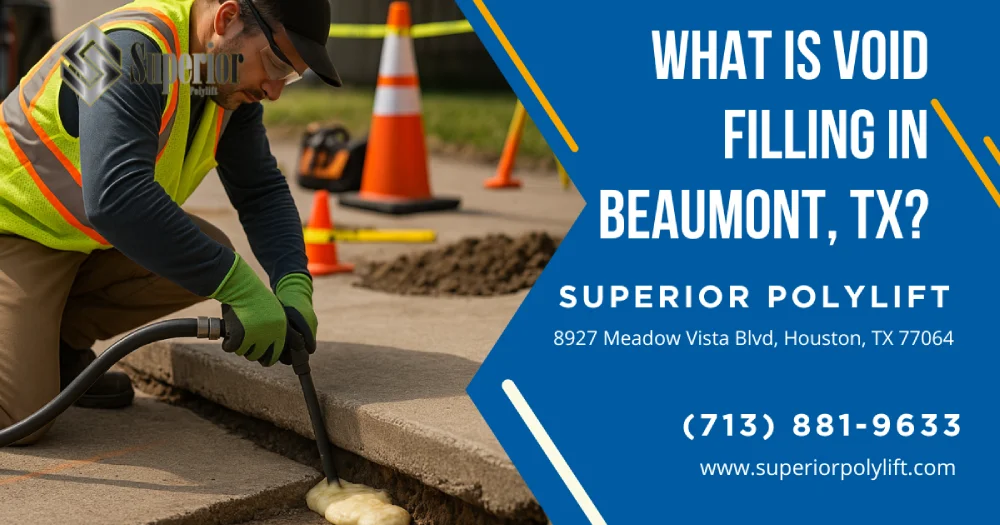
Wondering why a slab suddenly drops in the middle of a refinery or distribution center? Hidden “voids” lurking beneath concrete surfaces are usually the culprit. In Beaumont, TX, void filling—or void fill—is a geotechnical stabilization method that injects polyurethane foam, cement slurry, or flowable fill into gaps beneath concrete slabs. These injections re-compaction the soil mass, restore load-bearing capacity, and level critical infrastructure without costly tear-out and replacement.
Superior PolyLift™, Superior Grouting, and other specialized contractors across Beaumont, Lake Charles, LA, and Lafayette, LA rely on state-of-the-art equipment to deliver fast-curing mixtures that prevent further settlement, water infiltration, and structural damage. Done right, concrete void filling keeps petrochemical plants, ports, and heavy-haul corridors moving with minimal downtime.
Beaumont sits on alternating layers of clay, silt, and sandy loam. Seasonal rain and storm surge trigger soil erosion and infiltration that wash fines away, leaving voids under concrete. During dry spells, expansive clay shrinks, worsening void formation and compromising load-bearing capacity.
Poor drainage, broken French drains, or leaking conduit can funnel water beneath slabs. In chemical plants and refineries, frequent wash-downs and process water accelerate erosion, while heavy equipment compacts some areas and leaves others unsupported.
Forklifts, gantry cranes, and 18-wheelers generate vibrations that pump saturated soils out from beneath concrete structures, loosening anchor bolts and creating uneven surfaces. Without timely soil stabilization, even reinforced concrete slabs will crack and tilt.
| Material | Density (pcf) | Typical Cure Times | Ideal Use | Key Benefits | Considerations |
| High-Density Polyurethane Foam | 2-6 | 15-30 min | Concrete leveling with foam, conduit backfill | Expands 20–30×, water-resist, light | Temp-sensitive, skilled crew |
| Cementitious Grout | 90-120 | 8-24 hrs | Bridge approaches, anchor-bolt stabilization | High compressive strength | Heavy, may overstress weak soil |
| Flowable Fill / CLSM | 45-90 | 4-6 hrs | Utility trench backfill, refinery pipe racks | Self-leveling, excavatable | Longer cure, traffic control |
| Cellular Concrete | 20-60 | 4-8 hrs | Large voids, abandoned culverts | Ultra-lightweight, insulative | On-site batch plant needed |
Closed-cell foam injection is the flagship stabilization method for Superior PolyLift™, Corsair Concrete Lifting, and similar grouting solutions. The high-density mixture seeks out voids, inflates, lifts, and stabilizes concrete, resisting water infiltration and future erosion.
Low-strength or high-strength cement grout is pumped beneath concrete to backfill large cavities economically. Grouting services in Beaumont Texas often blend fly-ash or slag to improve environmental performance while meeting compressive-strength specs.
Where effective void filling requires several cubic yards of material—such as beneath tank farms or along pipeline corridors—flowable fill or cellular concrete provides lightweight, self-compacting backfill that reduces additional load on unstable soil.
Select a contractor that offers:
Ask about past work at Gulf Coast facilities, safety records, and engineered designs that prevent further settlement.
Pricing depends on port access, night-shift premiums, material volumes, and whether heavy-density foam or low-strength slurry is required. Still, most industrial owners recoup their investment through:
Void filling in Beaumont, TX, Lake Charles, LA, and Lafayette, LA delivers an effective, environmentally responsible stabilization method for concrete slabs in refineries, ports, and industrial corridors. Through precise foam or grout injection, Superior PolyLift™, Superior Grouting Services, and other providers restore grade, resist future erosion, and keep Gulf Coast infrastructure safe with minimal downtime. Need expert guidance? Contact a Beaumont-based void filling contractor today to schedule a site assessment and experience the superior benefits of modern concrete leveling with foam.

Explore how our expertise can benefit your project. Reach out to our team for a consultation and discover the best solutions for your needs.
Copyright © All rights reserved. 2024 • Terms of Use and Privacy Policy • Internet Marketing by Authority Solutions®